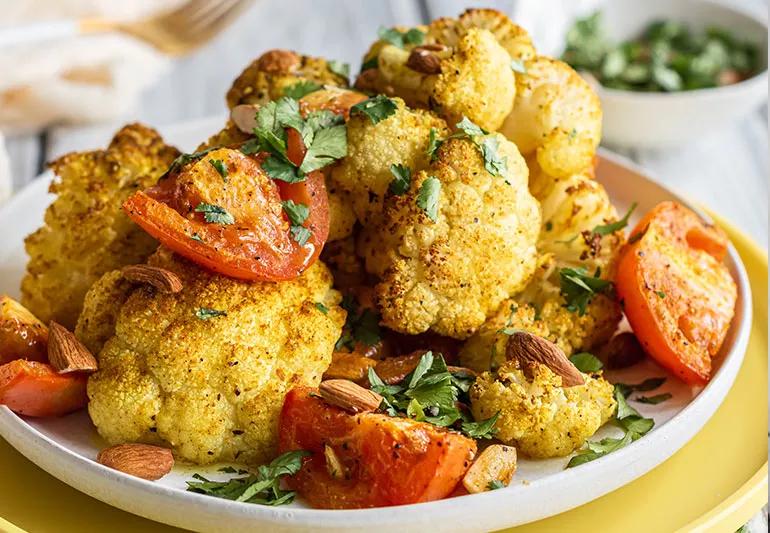From heat to sweet, curry is a versatile style of cuisine with hearty, healthy options galore

Is there anything quite as comforting as curry? Whether you like it mild or mega-spicy, there’s little that’s more soothing than the taste and aroma of spices like cumin, coriander, turmeric and ginger.
Advertisement
Cleveland Clinic is a non-profit academic medical center. Advertising on our site helps support our mission. We do not endorse non-Cleveland Clinic products or services. Policy
There are actually thousands of types of curry, as the word comes from the Tamil kari, which just means “sauce.” That means that whatever your flavor profile preference, you’re sure to find a curry dish that delights. Here are a few of our healthy, hearty favorites.

If curry is cozy, curry-spiced soup is the coziest. This Curried Squash and Sweet Potato Soup balances the sweetness of roasted squash and sweet potato with savory onion, garlic, ginger and curry powder.
Looking for a summer side instead? Creamy Curried Egg Salad spices up basic egg salad with an Indian-inspired twist (and the recipe includes the best technique for making easy-to-peel hard-boiled eggs!)

Give standard chicken salad a mega-makeover with this Open-Faced Curried Chicken Salad Sandwich. It’s bursting with flavor, texture and nutrients — and that’s before you even get to the protein-rich chicken.
If you want to cut the carbs and get your grill on instead, whip up some Indian Chicken Skewers with Potato-Cucumber Salad. The spice-marinated chicken comes off the heat juicy, zesty and ready to serve with a chilled, dill-forward salad.

All around the world, curry dishes feature fish and seafood as the main ingredient. Coconut Curry Cod With Bok Choy, for example, will light up your taste buds and — bonus! — it’s also incredibly simple to make. The cod poaches quickly, and it’s rich in protein and healthy fats.
Advertisement
Thai Swordfish in Red Curry Sauce is easy to make, too, and if you like the idea of the dish but aren’t a fan of the fish, you can swap it out for a firm seafood, like scallops, lobster-tail meat or shrimp. You can even substitute firm tofu to create a stunning vegetarian entree.

Not a meat eater? Curry helps veggies shine! Produce is the star of Curry Cauliflower with Tomatoes, Almonds and Cilantro, as the head veg in charge boasts impressive amounts of vitamin C, vitamin K and beta-carotene.
Massaman curry, a popular fusion of Thai, Indian and Persian flavors, is typically made with meat but doesn’t have to be. This Lighter Thai Vegetable Massaman Curry relies on chickpeas for protein, plus light coconut milk to keep saturated fat low without sacrificing flavor.
If you’re extra-confident in the kitchen, make your own buckwheat crepes to accompany Moroccan Vegetable Curry. Instead of coconut milk, this one calls for nonfat plain yogurt instead. It’s low in fat and sodium and a great source of lean protein and dietary fiber.

Rice is nice and all, but lentils, a low-fat, gluten-free legume, make for a perfectly protein-packed base for curried veggies. Hearty, petite French (green) lentils serve as the base of Lentils with Roasted Curry Tomatoes, a garlicky dish that elevates cherry tomatoes to a new level.
Curried Cauliflower Lentils with Cucumber Raita is another dish popular on many a restaurant’s menu, but if you make it at home, you can control your spice levels. For hot, hot heat, go with the Madras curry powder. A side of cooling raita, a yogurt-based condiment, will help temper the flames.
Advertisement
Learn more about our editorial process.
Advertisement

A flavorful side dish featuring South Asian spices

Try this deliciously different side dish

Spices and flavors that’ll have you feeling warm and satisfied

Swap regular fries for these delicious, and nutritious, potato wedges

Only 86 calories per serving!

Subtly sweet, buttery and vitamin-packed

An easy side you can make ahead of time

Start having sex about 72 hours before ovulation, then at least every other day during your fertile window

Attachment theory suggests that your earliest relationships shape connections throughout your life

It isn’t a recognized mental health disorder, but research shows that problematic social media use can negatively affect your mental health, self-esteem and sleep